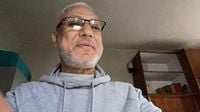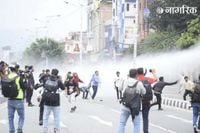In early September 2025, Nepal was rocked by a youth-led uprising that shook its political foundations and sent shockwaves through every corner of society. What started as a moral crusade by Gen Z activists—demanding an end to corruption, nepotism, and unaccountable governance—quickly spiraled into violence, exposing both the promise and peril of a digitally empowered generation determined to reshape their country’s future.
According to Republica, the Gen Z protests on September 8 and 9 were nothing short of transformative. Young Nepalis, frustrated by years of political inertia, coordinated online and took to the streets, toppling the government of KP Sharma Oli. Their message resonated with a public weary of the status quo, and for a brief moment, it seemed Nepal was on the brink of a new political era—one defined by youthful idealism and global awareness.
But as the days unfolded, the movement’s lack of unified leadership and clear vision left it dangerously exposed. Reports soon surfaced that various factions—including supporters of Durga Prasai, royalists, pro-Tibetan activists, and Maoist networks—sought to exploit the protests for their own agendas. The result was chaos. Individuals with criminal backgrounds and disruptive intent infiltrated the ranks, turning peaceful demonstrations into violent confrontations. In the end, the cost was staggering: seventy-six people lost their lives, with twenty-two of them young protesters who had taken to the streets with hope in their hearts.
The violence was not limited to clashes with police. Protesters were linked to arson and vandalism targeting some of Nepal’s most important institutions. Attacks were reported on Singh Durbar, the Supreme Court, the President’s Office, ministry buildings, five-star hotels, and private property. Experts told Republica that these acts bore the hallmarks of trained arsonists, not spontaneous protestors. The sight of burning buildings and ransacked homes shattered public sympathy for the movement and tarnished its legitimacy.
Businesses, in particular, felt the brunt of the unrest. As The Kathmandu Post reported, prominent business establishments were vandalized and set ablaze. Some businesspeople were forced to flee for their lives as mobs ransacked their homes. The Bhatbhateni chain of superstores, one of Nepal’s largest retail networks, was among the worst hit. Its owner, Min Bahadur Gurung, had become a lightning rod for criticism after donating land for a new office of the Communist Party of Nepal-United Marxist Leninist—the party of the ousted KP Sharma Oli. Many saw this gesture as emblematic of the unhealthy nexus between big business and political elites, further fueling the anger of the crowds.
Yet, as the dust settled, it became clear that the violence had deeper consequences. Over 1,000 criminals escaped from prisons during the protests, and nearly as many weapons were looted from police armories. Most remain unaccounted for, raising fears of further instability. Under pressure from various protest groups, the government released around 200 detainees linked to acts of arson, violence, and looting, leaving the police and business community demoralized. "If looters and thieves cannot be punished, what is the guarantee that the businesses will not be targeted again?" a business leader asked in The Kathmandu Post.
The economic fallout has been severe. Before the protests, Nepal’s economy was projected to grow by about 5 percent for the fiscal year. Now, the World Bank has slashed that figure to just 2.1 percent, citing deepening political and economic uncertainties. Preliminary estimates suggest approximately $700 million in damage to private property, and over 15,000 jobs have been directly affected. The private sector, responsible for 85 percent of formal jobs in Nepal, is reeling. Insurance companies face crippling claims, banks are struggling to recover loans, and investors are wary of making new bets in such a volatile environment.
The government’s response has been fraught with challenges. The interim administration, led by Prime Minister Sushila Karki, was handed the unenviable task of restoring order and preparing for nationwide elections scheduled for March 5, 2026. But with multiple new and competing groups vying for political influence—many of them offshoots or splinters of the original Gen Z movement—the path forward is anything but clear. The old political parties, still the largest stakeholders in the dissolved lower house, are locked in tense negotiations with Gen Z leaders over how to proceed. For now, formal conversations have begun, but progress remains tentative.
Meanwhile, the fragile security situation looms as another potential stumbling block. With so many weapons and criminals unaccounted for, and with the police force demoralized by the release of detainees, the risk of further violence is real. Businesses have been left feeling vulnerable and abandoned, with some comparing the current climate of fear to the darkest days of the Maoist insurgency from 1996 to 2006.
Further complicating matters, the government has cut off electricity to some major industries with long-overdue dues, forcing many to shut down. Nepal’s already limited industrial base is at risk of decimation, which could increase the country’s reliance on India for trade and open the door to a surge in cross-border smuggling. Tourism, another pillar of the economy, has also taken a hit as images of burning hotels and chaos have been broadcast around the globe, deterring both travelers and investors.
Amid this turmoil, the role of Kathmandu Mayor Balen Shah has come under scrutiny. Widely considered a prominent figure among young reformists, he conspicuously avoided taking visible leadership during the height of the movement. Instead, he operated behind the scenes during the formation of the new government, exerting pressure on Prime Minister Karki and Home Minister Aryal. His silence at a critical moment has raised questions about influence without responsibility. As Republica noted, "His silence when leadership was most needed exposed hesitation rather than conviction."
Now, with the High-Level Probe Committee led by Gauri Bahadur Karki investigating the violence, infiltration, and coordination behind the September unrest, the government is under immense pressure to maintain law and order while not succumbing to powerful networks that could repeat Nepal’s cycle of instability and unfulfilled promises.
For the Gen Z movement, the events of September serve as a sobering lesson. Their ability to topple a government was undeniable, but their failure to translate momentum into constructive leadership created a vacuum quickly filled by opportunists. The movement’s fragmentation—into competing factions, pressure groups, and media personalities—has left genuine reformists overshadowed by well-funded actors with political motives. As Republica observed, "The Gen Z movement’s struggle to produce credible leadership underscores a deeper lesson: protest alone is not enough. Meaningful change requires sustained engagement, political maturity and willingness to endure beyond the streets."
If Gen Z truly wants to reshape Nepal, it must distance itself from external manipulators and embrace structured political participation. Otherwise, this moment may be remembered not as a turning point, but as another missed opportunity in Nepal’s long history of broken hopes. The coming months, leading up to the crucial March elections, will reveal whether Nepal’s youth can turn their idealism into lasting reform—or whether the country will once again be caught in the undertow of instability.

